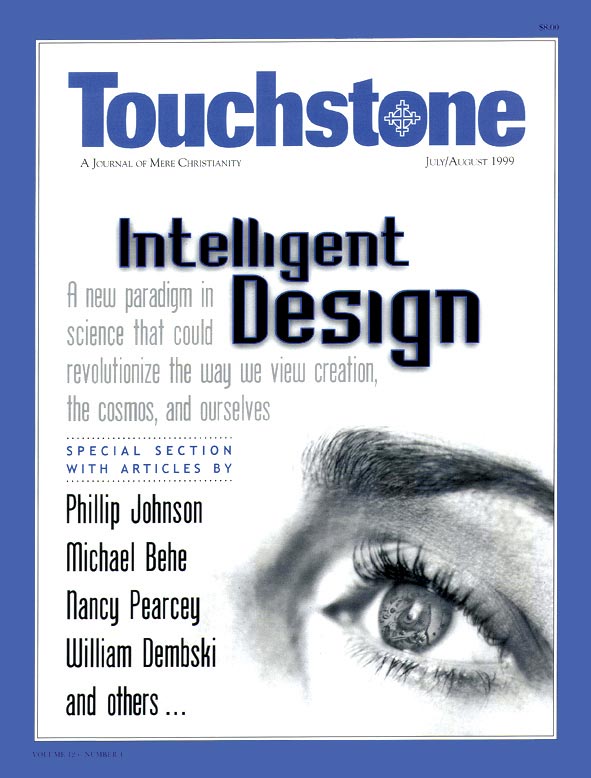The Wedge
Breaking the Modernist Monopoly on Science
by Phillip E. Johnson
The movement we now call the Wedge made its public debut at a conference of scientists and philosophers held at Southern Methodist University in March 1992, following the publication of my book Darwin on Trial. The conference brought together as speakers some key Wedge figures, particularly Michael Behe, Stephen Meyer, William Dembski, and myself. It also brought a team of influential Darwinists, headed by Michael Ruse, to the table to discuss this proposition: “Darwinism and neo-Darwinism as generally held in our society carry with them an a priori commitment to metaphysical naturalism, which is essential to making a convincing case on their behalf.” As I wrote in my introduction to the first edition of the papers from that conference,
I do not think the issue was ever really confronted on this question. . . . What the anti-Darwinists called metaphysical naturalism the Darwinists called “science,” and they insisted that for science to cease being naturalistic would be for it to cease being science. To put the matter in the simplest possible terms, the Darwinist response to the question presented was not “No, that is wrong, because the case for Darwinism can be made without assuming a naturalistic perspective.” Instead, they answered “So what? All that you are really saying is that Darwinism is science.”
That may seem a deadlock, but the amazing thing was that a respectable academic gathering was convened to discuss so inherently subversive a proposition. I was sure that in the long run discussions of that sort would be fatal for Darwinism because they would reveal that the theory finds its justification in philosophy, not evidence. Biologists have legitimate authority to tell us the facts that they observe, in the field and in their laboratories. They have no authority to tell the rest of us what metaphysical assumptions we must adopt. Once it becomes clear that the Darwinian theory rests upon a dogmatic philosophy rather than the weight of the evidence, the way will be open for dissenting opinions to get a fair hearing. In a nutshell, that is the Wedge strategy. Now that several years have passed and a new century is almost upon us, it is time to review how the Wedge has grown and progressed, to evaluate how far we have come, and to forecast what we expect to accomplish in the next decade. But first I need to explain the intellectual background in more detail.
The Background
Most persons who have written about creation and evolution have assumed that they were entering a debate over facts and evidence, and their objective accordingly has been to state in detail what they consider to be the facts and to support their conclusions with evidence. Darwinian evolutionary scientists assert confidently that the Genesis account is mythology, that the earth is billions of years old, that the first primitive living organism emerged from a chemical soup by some combination of chance and chemical laws, and that life thereafter evolved to its present diversity by natural means, guided by natural selection but not by God. Theistic evolutionists defend basically the same account, adding that the evolutionary process was sustained and guided by God in some manner that cannot be detected by scientific investigation. Biblical creationists defend the Genesis account, arguing that Darwinian evolution is bad or biased science while differing among themselves about such important details as whether the “days” of Genesis were twenty-four-hour periods or geological epochs, and whether Noah’s flood was worldwide or local. The argument never goes anywhere.
The Darwinists hold the dominant position in the sense that only their position is taught in public education or promoted in the national media. Nevertheless, they are frustrated and worried that so much resistance remains, especially in North America. Scientists, educators, museum curators, and others have made determined efforts to convince the public, but public opinion polls indicate that the public isn’t getting the message. Over 40 percent of Americans seem to be outright creationists, and most of the remainder say they believe in God-guided evolution. Less than 10 percent express agreement with the orthodox scientific doctrine that humans and all other living things evolved by a naturalistic process in which God played no discernible part. These figures, from recent polls, are practically unchanged from previous polls in the early 1980s. The Darwinists hold a commanding power position for the time being, but they have not convinced the masses. The situation is sufficiently precarious that in 1998 the National Academy of Sciences found it necessary to issue a guidebook on Teaching About Evolution and the Nature of Science (hereafter Guidebook) urging public school teachers to “teach evolution”—i.e., to promote the neo-Darwinian theory—regardless of local opposition.
By “teaching about evolution” the National Academy emphatically does not mean that the teachers should inform students candidly about why the subject is so controversial, and it especially does not want them to make students aware of the dissenting arguments (except perhaps in caricatured form, as presented by Darwinists like Carl Sagan and Stephen Jay Gould). Instead, the Guidebook encourages teachers to mollify the religious people with vague reassurances that “religious faith and scientific knowledge, which are both useful and important, are different,” and to deny that there is any real controversy because “there is no debate within the scientific community over whether evolution has occurred.” To make the controversy disappear, the Guidebook defines evolution so broadly (“descent with modification”) that it “occurs” every time a baby is born. Who can deny that babies are born, and dogs are bred, or that the gene pool is constantly being modified?
This strategy of trivializing the subject might be effective if the science educators and their allies completely controlled the channels of communication, but increasing numbers of high-school and college students come to the classroom already knowing that there are reasonable grounds for dissent, advocated by persons (such as the authors represented in this journal issue) with impressive scientific and academic credentials. The best-informed students also know that prominent writers like Richard Dawkins, Carl Sagan, Edward O. Wilson, and Daniel Dennett promote atheism in the name of evolutionary science, with the apparent approval of the scientific establishment. (Other authorities like Stephen Jay Gould purport to be more friendly to “religious belief,” but only on the condition that religious authorities stick to questions of moral values and defer to science on all issues of fact.) When the National Academy dodges all the tough questions with evasive platitudes, it effectively teaches independent-minded students to regard the pronouncements of science educators with no more trust than they regard political or commercial advertisements. Eventually the scientific community will pay a high price for this campaign of prevarication.
The Two Models of “Science”
The science educators don’t want to be dishonest, but they don’t know any other way to deal with people who are so irrational as to deny that our existence is best explained by evolution. The educators also think that they are giving as much respect to religious belief as they honestly can, and that to be more explicit on the subject would merely cause unnecessary offense and provoke emotional opposition. In consequence, they assume that an honest dialogue is impossible, and so they see no alternative but to counter the opposition with tactics of intimidation, evasion, and propaganda. Similarly, dissenters from evolutionary orthodoxy are often astonished that so many scientists cannot see that there is a genuine scientific case against Darwinism, and that widespread dissent cannot be dismissed out of hand as the product of ignorance or prejudice. Why can’t eminent scientists seem to grasp the obvious point that finch-beak variation does not even remotely illustrate a process capable of making birds in the first place?
The reason for this deadlock is quite simple. In our culture there are two distinct models of the scientific enterprise, and the persuasiveness of the case for Darwinian evolution depends entirely on which model you adopt.
In the first, materialist model, science is seen as based by definition upon philosophical naturalism or materialism. For present purposes naturalism and materialism amount to the same thing. The first asserts that nature is all there is, while the second adds that nature is made up of matter, i.e., the particles that physicists study, and nothing else. (Philosophers tend to prefer the less familiar term physicalism, because it avoids the ordinary-language distinction between matter and energy—energy being also a physical entity.) Whichever term is used, every event or phenomenon is conclusively presumed to have a material cause, at least after the ultimate beginning. Within this first model, to postulate a non-material cause—such as an unevolved intelligence or vital force—for any event is to depart altogether from science and enter the territory of religion. For scientific materialists, this is equivalent to departing from objective reality into subjective belief. What we call intelligent design in biology is by this definition inherently antithetical to science, and so there cannot conceivably be evidence for it.
The second, or empirical model defines science strictly in terms of accepted procedures for testing hypotheses, such as repeatable experiments. (I use the term “empirical” here in its dictionary sense of “arising from observation or experiment”—as opposed to arising by deductive reasoning from philosophical axioms.) Of course scientific materialists also employ these testing procedures, but only up to the point where materialism itself comes into question. For true empiricists, whatever is testable by scientific methods is eligible for consideration. Within science one cannot argue for supernatural creation (or anything else) on the basis of ancient traditions or mystical experiences, but one can present evidence that unintelligent material causes were not adequate to do the work of biological creation. Whether some phenomenon could have been produced by unintelligent material causes, or whether an intelligent cause must be postulated, is eligible for investigation whether the phenomenon in question is a possible prehistoric artifact, a radio signal from space, or a biological cell.
If you adopt the materialist model, a materialistic evolutionary process that is at least roughly like neo-Darwinism follows as a matter of deductive logic, regardless of the evidence. Otherwise, how could complex organisms exist? To say that they are the product of design by an unevolved intelligence, even one that works by guiding evolution, would be to repudiate materialism and hence to abandon science. Before life, especially intelligent life, can come into existence, it must evolve from unintelligent matter by a naturalistic mechanism that must by definition be unintelligent. That mechanism must employ some combination of random variation and physical law (the principle of natural selection being a sort of law), because nothing else could have been available.
This kind of deductive reasoning is so overpowering to materialists that Darwinists sometimes say that their theory is as self-evidently true as the basic principles of arithmetic. Evolutionary biologist Paul Ewald exemplifies this Darwinian logic: “Darwin only had a couple of basic tenets. . . . You have heritable variation, and you’ve got differences in survival and reproduction among the variants. That’s the beauty of it. It has to be true—it’s like arithmetic. And if there is life on other planets, natural selection has to be the fundamental organizing principle there, too.” (Jill Cooper, “A New Germ Theory,” The Atlantic, February 1999.) The fallacy here is that from the proposition “heritable variation and differential survival occur,” it does not follow that these factors have any substantial creative power.
Scientific empiricists, as I use the term, hold that there are three kinds of causes to be considered rather than only two. Besides chance and law, there is also agency, which implies intelligence. Intelligence is not an occult entity, but a familiar aspect of everyday life and scientific practice. No one denies that such common technological artifacts as computers and automobiles are the product of intelligence, nor does anyone claim that this fact removes them from the territory of science and into that of religion.
It is also common in scientific practice to infer the existence of something that is not observable (cold dark matter, extinct ancestors that were not fossilized) because it is thought necessary to explain the phenomena that are observable. For example Carl Sagan’s SETI (Search for Extraterrestrial Intelligence) radio telescopes search the sky for evidence of radio signals from space aliens. If they were to receive a signal containing a sequence of prime numbers, as portrayed in the movie Contact, they would conclude that it came from intelligent beings—without the need for independent evidence of the existence and nature of the aliens.
Evidence of intelligent design is permissible in such cases because it does not conflict with materialist metaphysics, the aliens being presumed to have evolved by natural selection. The proposition that the biological cell is the work of intelligence is out of the question for materialists not because of the evidence but because—in the words of famed Harvard University geneticist Richard Lewontin—“[our] materialism is absolute, we cannot allow a Divine Foot in the door.”
The confusion between these two models sets the stage for an unproductive argument that can never go anywhere. Scientific materialists think that advocates of intelligent design (ID) are either irrational or dishonest, because they are advocating as science a proposition that ought to be confined to religion, namely the claim that scientific evidence points to the reality of a designing intelligence in the origin and development of life. Moreover they claim to have positive evidence for intelligent design in biology when the rules of science-as-materialism specify that such a thing cannot exist. Materialists classify such people not as empiricists but as “creationists,” a term that in materialist jargon means biblical literalism and is inherently pejorative, suggesting a combination of irrationality and intellectual dishonesty. Hence materialists insist that “creationism,” including any consideration of ID, must be banned from scientific discussions, and even from public discourse altogether, as a reprehensible and unconstitutional attempt to pass off religion as science.
We who are willing to consider evidence for ID, on the other hand, think of ourselves as the true empiricists and hence the true practitioners of scientific thinking. From our standpoint it is the materialists who are the “fundamentalists,” in the pejorative sense of the term, because they adhere to a metaphysical dogma in the teeth of contrary scientific evidence. If design is a legitimate subject for scientific investigation in the case of computers, communications from space aliens, and peculiar markings on cave walls, why should it be arbitrarily excluded from consideration when dealing with the biological cell or the conscious mind? Whether the evidence actually does support design hypotheses in biology is a point in dispute, of course, but in our opinion the scientific materialists effectively concede the point when they adamantly refuse to admit a distinction between “materialism” and “science.” They must realize at some level that they cannot win the argument on the basis of evidence, and therefore must win it by imposing a definition of science that disqualifies their critics regardless of the evidence.
Two Examples from the National Academy of Sciences
The policy of supporting Darwinism and materialism leads science educators to present the subject in a manner that actively discourages students from cultivating the critical thinking skills that are essential in real scientific research. Students are also never prepared to understand public controversies over subjects like social Darwinism and genetic determinism because the educators present a whitewashed version of their theory. I’ll give two illustrations, both involving the National Academy’s Guidebook. I choose this particular text as an example because it is simple, recent and has the official imprimatur of the nation’s most prestigious scientific organization. Similar confusions abound in the literature of evolution at every level.
On page 19, the Guidebook describes one of the most frequently cited examples of natural selection, in a section titled “Ongoing Evolution Among Darwin’s Finches.” Here is the complete text:
A particularly interesting example of contemporary evolution involves the 13 species of finches studied by Darwin on the Galapagos Islands, now known as Darwin’s finches. A research group led by Peter and Rosemary Grant of Princeton University has shown that a single year of drought on the islands can drive evolutionary changes in the finches. Drought diminishes supplies of easily cracked nuts but permits the survival of plants that produce larger, tougher nuts. Drought thus favors birds with strong, wide beaks that can break these tougher seeds, producing populations of birds with these traits. The Grants have estimated that if droughts occur about once every 10 years on the islands, a new species of finch might arise in only about 200 years.
A good science teacher might employ humor to illustrate the fallacy of extrapolation here. “If the average length of finch beaks in a population increases five per cent following drought years, and droughts occur every ten years, how long will it take the beaks to grow from an average of one inch in length to ten feet, or for finches to become eagles?” It is no wonder that the Guidebook’s authors did not quote the title of the Grant’s 1987 paper in Nature, “Oscillating Selection in Darwin’s Finches,” because that would have signaled to teachers, and perhaps also to bright students, that the finch-beak example involves no continuing directional change at all. The drought year in question was followed a few years later by floods, and the average beak size promptly went back to normal. But even if finches did grow steadily larger for a time, would this show that they can change into something completely different?
This example is not taken out of context, nor is it atypical. It follows the thesis of The Beak of the Finch, by Jonathan Weiner, a book that won the Pulitzer Prize in 1995 and has been enthusiastically recommended to the public by leading authorities, including the president of the National Academy of Sciences. It is easy to see why the Darwinists feel they have to present evidence in a selective and slanted manner. Under any kind of objective analysis, it would become apparent that the Darwinists have never discovered a mechanism capable of creating new complex organs, or changing one kind of body plan into another. (The finch-beak example is given top billing in the textbooks precisely because the other known examples of observed natural selection are even less impressive.) The Darwinist educators are determined to persuade rather than to educate, and so their textbooks have to bluff.
If a stock promoter drafted a prospectus the way the Guidebook presents the finch-beak story, by padding assets and concealing liabilities, purchasers would be entitled to recover damages for fraud and the promoter might go to jail. Yet scientific materialists do not consider such presentations to be dishonest, for the same reason that they do not consider it dishonest to omit from the high-school textbooks (as they do) any mention of the sudden and mysterious appearance of the animal phyla in the Cambrian explosion. Specific evidentiary problems can’t be all that serious, they reason, since some materialist process has to have done all the creating regardless of the evidence. If the mechanism that produced the Cambrian explosion is not yet fully understood, this is a problem for advanced researchers. Students can’t be taught everything at once, and to avoid encouraging them in unsound ways of thinking it is best not to make them aware of the kind of evidence that causes people to form doubts.
I could give many other examples of how Darwinian educational materials present scientific evidence selectively or misleadingly, but for my second example I would rather discuss an important sin of omission. Readers today are virtually assaulted with books by eminent scientific authorities presenting a materialist and determinist worldview in the name of science. The Harvard zoologist Edward Wilson’s 1998 book Consilience argues that not only scientists but also theologians and literary scholars should base their work strictly on Darwinian assumptions. Philosopher Daniel Dennett describes Darwin’s theory as a “universal acid; it eats through just about every traditional concept and leaves in its wake a revolutionized world view.” (The view that God is a valid source of moral standards is one of those traditional concepts that Darwin’s theory eats through, notwithstanding the vague reassurances science educators provide for religious parents.)
Influential evolutionary psychologists like Steven Pinker and Robert Wright describe human behavior as the product of genetic programs honed by natural selection, while eminent evolutionists of the political left, such as Stephen Jay Gould and Richard Lewontin, describe evolutionary psychology as a pseudoscience honed by prejudice. Molecular geneticists propose projects to alter the human genome, at first to eliminate specific genetic defects and then eventually to improve the species overall. They see no reason to respect the existing design of an organism that was produced by unintelligent mechanisms that could hardly be expected to do the job right.
Behind all the specific controversies lies one important question that the educators systematically evade. Are evolutionary and materialist assumptions merely a convention of scientific investigation, or are they valid for all purposes? When science educators are trying to justify excluding non-materialistic thoughts from the science curriculum, they tend to portray science as merely “one way of knowing,” with the implication that other ways of knowing are equally valid. When you press them to specify which other ways of knowing are as valid as science, they can’t think of any examples. It turns out that what they really mean is that science is the only way of knowing, and outside of science there are only subjective beliefs and feelings. A typical comment is that one can “feel” a sense of awe or beauty towards some object like the rainbow, even though we know through scientific investigation how the color spectrum is produced. Religious “faith,” aesthetic “feelings,” and moral “beliefs” are continually contrasted with scientific “knowledge,” a division that assumes that only science provides truths that are valid for everybody.
For those who think that science is the only path to knowledge, and there are many such in the National Academy, it is important to extend the realm of science as far as possible to avoid a complete relativism on all subjects involving any question of value. This explains why pseudoscientific fads such as behaviorism, Freudianism, Marxism, and social Darwinism tend to gain so much influence, and to reappear in new guises every time they are discredited. It also explains why thinkers who don’t claim scientific authority tend to teach that all knowledge is relative to particular interpretive communities. When only science is deemed capable of creating knowledge, ambitious worldview-proclaimers will either style themselves as scientists, or say that their nihilism is itself an inevitable consequence of scientific knowledge. Is it true that science is the only way of gaining objective knowledge, and that outside of science there is only subjective faith and belief? That is the message the National Academy apparently wishes to convey, but it does so by persistent insinuation rather than explicit statement in order to maintain the pose of neutrality towards “religious belief.”
The Right Question
In short, our scientific leadership is in a philosophical muddle and is only making things worse with its campaign of intimidation, factual misrepresentation, and semantic legerdemain. To put things on a more rational basis, the first thing that has to be done is to get the Bible out of the discussion. Too many people, including journalists, have seen the movie Inherit the Wind and have become convinced that everyone who questions Darwinism must want to remove the microscopes and textbooks from the biology classrooms and just read the book of Genesis to the students. It is vital not to give any encouragement to this prejudice, and to keep the discussion strictly on the scientific evidence and the philosophical assumptions. This is not to say that the biblical issues are unimportant; the point is rather that the time to address them will be after we have separated materialist prejudice from scientific fact.
The question for now is not whether the vast claims of Darwinian evolution conflict with Genesis, but whether they conflict with the evidence of biology. To make that question visible, it is necessary to distinguish between the dictates of materialist philosophy and the inferences that one might legitimately draw from the evidence in the absence of a materialist bias. So I put this simple question to the Darwinian establishment: What should we do if empirical evidence and materialist philosophy are going in different directions? Suppose, for example, that the evidence suggests that intelligent causes were involved in biological creation. Should we follow the evidence or the philosophy?
Scientific materialists find that question impossible to answer, or even to comprehend, because they identify materialism not only with science, but also with rationality itself. In their minds the only alternative to materialism is a chaotic animism in which science is impossible because all events occur at the whim of capricious spirits, a world in which every question about causation can be answered with a shrug and the remark “it must be the will of God.” This is nonsense, of course. The very idea of natural laws stems from the concept that the world is ruled by a rational lawgiver, just as it is a historical fact that modern science grew out of a worldview guided by biblical theism. One of the absurdities of materialism is that it assumes that the world can be rationally comprehensible only if it is entirely the product of irrational, unguided mechanisms. Another absurdity is that the scientific mind itself was designed by natural selection, a force that rewards only superiority at reproduction and by whose standards the mind of the cockroach is every bit as effective as the mind of Einstein. On the contrary, the rationality and reliability of the scientific mind rests on the fact that the mind was designed in the image of the mind of the Creator, who made both the laws and our capacity to understand them.
Diehard materialists will never agree that there can be a contradiction between the findings of empirical science and the dictates of materialist philosophy, but more open-minded thinkers will grasp the possibility at once. To get the necessary reconsideration going, the first priority for critics of scientific materialism is to state the critique of materialism and naturalism in language that the intellectual community can recognize as legitimate. In the world of the university it is not legitimate to set up the Bible as authority against the evidence of scientific observation, but it is very legitimate to show that people who claim to be basing their ideology on observation or neutral reasoning are actually proceeding on the basis of powerful hidden assumptions. It is also legitimate to show that a specific scientific observation—such as the finch-beak example—appears to be evidence that natural selection has creative power only if you interpret the evidence with a powerful materialist bias.
The Wedge Strategy
This is where the Wedge comes in. To get the intellectual world discussing a new and possibly unwelcome question, it is not enough just to write a book or make an argument. We have to inspire a lot of people to start doing intellectual work based on the right questions, work of such high quality and persuasive force that the world cannot avoid discussing it. These thinkers have to produce books and articles that explore in detail what happens when you call materialism into question rather than take it for granted. As the discussion proceeds, the intellectual world will become gradually accustomed to treating materialism and naturalism as subjects to be analyzed and debated, rather than as tacit foundational assumptions that can never be criticized. Eventually the answer to our prime question will become too obvious to be in doubt. When the philosophy conflicts with the evidence, real scientists follow the evidence. It will be equally obvious that thinkers outside of science should not allow scientists to abuse their proper authority by forcing dubious philosophical assumptions on the rest of the world. The answers will take care of themselves once the discussion is directed to the right questions.
The metaphor of the Wedge portrays the modernist scientific and intellectual world, with its materialist assumptions, as a thick and seemingly impenetrable log. Such a log can be split wide open, however, if you can find a crack and pound the sharp edge of a wedge into it. There are a number of inviting cracks in modernism, but probably the most important one involves its creation story, and the huge gap between the materialist and empiricist definitions of science. My own writing and speaking represents the sharp edge of the Wedge. I make the first penetration, seeking always only to legitimate a line of inquiry rather than to win a debate, measuring success by the number of significant thinkers I draw into the discussion rather than by the conclusions that they draw for the present.
There are some very gifted people following me into the gradually widening opening, taking the discussion to levels I could never reach by myself. The first and most famous example is Michael Behe. I explained in layman’s terms why the Darwinian mechanism can’t do what it has to do, and Behe explained in scientific terms exactly what that means when you understand how biology operates at the molecular level. Behe’s book Darwin’s Black Box has sold a lot of copies and received a lot of reviews. The reviewers say what I knew they would say: Behe’s scientific description is accurate, but his thesis is unacceptable because it points to a conclusion that materialists are determined to avoid. Of course, the reviewers tend to be philosophically naive souls who mix the two models up in their minds. They think that sticking to the evidence means sticking to materialism regardless of the evidence. That kind of logic may satisfy those who are highly prejudiced in favor of materialism, but it will not work with those who are inclined to doubt.
After Behe comes William Dembski, with his remorselessly rigorous The Design Inference. Dembski’s philosophical and mathematical reasoning is highly sophisticated, but his fundamental proposition is pure common sense. It is that intelligent causes can do things that unintelligent causes cannot do, and scientific investigation can tell the difference. I attended a seminar on Dembski’s ideas recently at a major university philosophy department, where I saw from the reactions how common it is for clever people to deploy their mental agility in the service of obscurity. But Dembski put the concept of intelligent design on their mental maps, and eventually they will get used to it.
After Dembski come a lot more. My sense is that the battle against the Darwinian mechanism has already been won at the intellectual level, although not at the political level. When I debate Darwinists, they rarely try to defend examples like finch-beak variation as showing a mechanism that can really create complex genetic information or the sort of molecular mechanisms that Behe’s book describes. Instead, they shift the burden of proof to the skeptics, arguing that the mere fact we don’t have a satisfactory mechanism for now doesn’t necessarily mean that one will not be discovered at some time in the future. (For reasons previously explained, scientific materialists consider the promise of a materialist mechanism in the future to be equivalent to the demonstration of a mechanism in the present. If the whole system is as true as arithmetic, the missing mechanism will inevitably be discovered.) When they are on the defensive, Darwinists frequently dismiss the mechanism as a mere detail, insisting that all scientists are agreed that “evolution is a fact,” even though they may disagree about exactly how it occurred. Evolution without a specific mechanism is too vague to be testable. The theory claims, for example, that an ancestral bacterium produced distant descendants as diverse as the worm and the lobster. How can one test such an ambitious claim if no details of the transformation are specified?
When the claim that large-scale evolutionary changes occur is made specific, then it becomes testable. So far the claim is failing the tests. Wedge members Paul Nelson and Jonathan Wells have shown this by describing the dissimilarity of supposed evolutionary cousins at the earlier embryonic stages, and by reviewing the literature describing attempts by biologists to change the direction of embryonic development by inducing mutations in the DNA. What the results show is that mutations either have no effect on the developing embryo or they have a damaging effect, leading to death or birth defects unless the developmental repair mechanisms can fix the damage. What mutations never do is to change the direction of development, as would have to happen if evolutionary transformation were to occur. To put it simply, you may believe on philosophical grounds that large-scale evolutionary transformations must have occurred, but this belief finds no support in the experimental evidence. If they did occur, no one knows how.
The Future
Persons who consider only the cultural power of evolutionary naturalism and see how thoroughly it dominates the contemporary mind, may suppose that the Wedge’s critique of scientific materialism is a quixotic venture that can never succeed. On the contrary, I think our success is all but inevitable. In arguing that we should distinguish between objective empirical testing on the one hand and deductive reasoning from materialist philosophical assumptions on the other, we are making a point of elementary logic that is irresistible once it is understood. The only obstacle to a breakthrough is the longstanding prejudice, so deeply ingrained in educational practice, which says that materialism and science are the same thing, and that there cannot be evidence of design in biology because materialist prejudice forbids it. A prejudice like that can be protected for a while, but in the end reason always breaks through.
I measure our success in two ways. First, many thousands of high-school and college students are reading our literature, and are responding very favorably. As they learn that the official textbooks present the evidence selectively, and even distort it in the manner illustrated by the finch-beak example, many become highly motivated to challenge the dogmatic system that is being foisted on them. The most talented of these will be the Wedge members of the future. Second, the Darwinists are completely unable to meet our challenge at the intellectual level, and scarcely try. Their literature continues to promote the view that the only dissenters from Darwinism are religious fundamentalists who don’t know about the overwhelming evidence that proves that “evolution has occurred.” This caricature of the opposition works only with people who have never heard the dissenting arguments firsthand. With the growth of private schooling (including home schooling) and the Internet, it is no longer as easy as it was for educators to ensure that students hear only the official version of the story. Once independent-thinking young people have read the dissenting literature, they are not likely to be impressed with the evasive statements of the Darwinist establishment.
Success for the Wedge does not mean replacing one dogmatic system with another. Our objective is not to impose a solution, but to open the most important areas of intellectual inquiry to fresh thinking. If the fall of Darwinism inspires materialists to develop a new theory that can survive unbiased scientific testing, then so be it. If they can’t do that, then the world will face the astonishing truth that the evidence of biology actually supports the popular belief that living organisms are the product of an intelligent creator rather than a blind material force. When that realization sinks in, the next big project on the intellectual agenda will be to understand why so many brilliant people fooled themselves so completely for so long. Exploring that question will make the twenty-first century a very exciting time.
Two Key TermsDarwinism: Living things originate through descent with modification (descent means descent from one or a few primitive ancestral forms; modification means natural selection of random variations). Neo-Darwinism: Same as above, but with the process of modification cast in genetic terms (genetic mutations are the source of variations, and natural selection produces changes in gene frequencies). |
The Peppered Moth StoryThe National Academy’s Guidebook ignores the standard textbook example of evolution by natural selection, the peppered moths of the English midland forests. This moth population was predominantly light-colored in the early nineteenth century, and then became predominantly dark during the late nineteenth century. According to the textbook story, the moths rest during the day on tree trunks and are eaten there by birds. While the tree trunks were light-colored, the light moths were better camouflaged, but the dark moths had the advantage after the trunks became dark due to the effects of industrial pollution. The light moths made a comeback after the advent of air pollution control laws in the 1950s. Even taken at face value, the moth story (like the finch-beak story) involves no innovation or directional change. Discoveries in the 1980s showed, moreover, that the moths do not normally rest on tree trunks. All textbook photographs of peppered moths on tree trunks were produced either by manually positioning live moths (which are torpid during the day) or by gluing dead moths to tree trunks. The textbook story is now thoroughly discredited, and its continued use shows how desperate Darwinists are to provide confirmation for their cherished theory. See Coyne, “Not Black and White,” Nature, vol. 396, pp. 35–36 (1998). |
Phillip E. Johnson is Professor of Law (emeritus) at the University of California at Berkeley. He is the author of Darwin on Trial, The Wedge of Truth, The Right Questions (InterVarsity Press), and other books challenging the naturalistic assumptions that dominate modern culture. He is a contributing editor of Touchstone.
subscription options
Order
Print/Online Subscription

Get six issues (one year) of Touchstone PLUS full online access including pdf downloads for only $39.95. That's only $3.34 per month!
Order
Online Only
Subscription

Get a one-year full-access subscription to the Touchstone online archives for only $19.95. That's only $1.66 per month!
bulk subscriptions
Order Touchstone subscriptions in bulk and save $10 per sub! Each subscription includes 6 issues of Touchstone plus full online access to touchstonemag.com—including archives, videos, and pdf downloads of recent issues for only $29.95 each! Great for churches or study groups.
Transactions will be processed on a secure server.
more on science from the online archives
more from the online archives
calling all readers
Please Donate
"There are magazines worth reading but few worth saving . . . Touchstone is just such a magazine."
—Alice von Hildebrand
"Here we do not concede one square millimeter of territory to falsehood, folly, contemporary sentimentality, or fashion. We speak the truth, and let God be our judge. . . . Touchstone is the one committedly Christian conservative journal."
—Anthony Esolen, Touchstone senior editor












